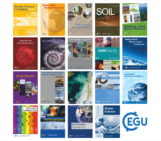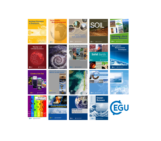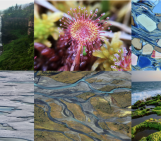
Each month we feature specific Divisions of EGU and during the monthly GeoRoundup we will be putting the journals that publish science from those Divisions at the top of the Highlights roundup. For July, the Divisions we are featuring are: Natural Hazards (NH) and Geomorphology (GM). They are served by the journals: Geoscientific Model Development (GMD), Natural Hazards and Earth System Sciences (NHESS), Earth Surface Dynamics (ESurf) and Solid Earth (SE).
Featured highlights
Geoscientific Model Development:
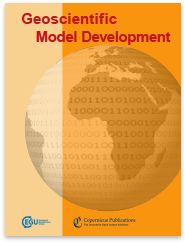 FaIRv2.0.0: a generalized impulse response model for climate uncertainty and future scenario exploration – 9 July 2021
FaIRv2.0.0: a generalized impulse response model for climate uncertainty and future scenario exploration – 9 July 2021
This paper presents an update of the FaIR simple climate model, which can estimate the impact of anthropogenic greenhouse gas and aerosol emissions on the global climate. This update aims to significantly increase the structural simplicity of the model, making it more understandable and transparent. This simplicity allows it to be implemented in a wide range of environments, including Excel. We suggest that it could be used widely in academia, corporate research, and education.
A discontinuous Galerkin finite-element model for fast channelized lava flows v1.0 – 23 July 2021
Lava flows present a natural hazard to communities around volcanoes and are usually slow-moving (< 1-5 cm/s). Lava flows during the 2018 eruption of Kilauea volcano, Hawai’i, however, reached speeds as high as 11 m/s. To investigate these dynamics we develop a new lava flow computer model that incorporates a nonlinear expression for the fluid viscosity. Model results indicate that the lava flows at Site 8 of the eruption displayed shear thickening behavior due to the flow’s high bubble content.
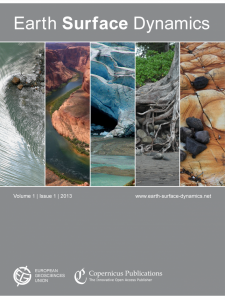 Interactions between deforestation, landscape rejuvenation, and shallow landslides in the North Tanganyika–Kivu rift region, Africa – 12 July 2021
Interactions between deforestation, landscape rejuvenation, and shallow landslides in the North Tanganyika–Kivu rift region, Africa – 12 July 2021
We investigated how shallow landslide occurrence is impacted by deforestation and rifting in the North Tanganyika–Kivu rift region (Africa). We developed a new approach to calculate landslide erosion rates based on an inventory compiled in biased © Google Earth imagery. We find that deforestation increases landslide erosion by a factor of 2–8 and for a period of roughly 15 years. However, the exact impact of deforestation depends on the geomorphic context of the landscape (rejuvenated/relict).
Rarefied particle motions on hillslopes – Part 1: Theory – 30 July 2021
Sediment particles skitter down steep hillslopes on Earth and Mars. Particles gain speed in going downhill but are slowed down and sometimes stop due to collisions with the rough surface. The likelihood of stopping depends on the energetics of speeding up (heating) versus slowing down (cooling). Statistical physics predicts that particle travel distances are described by a generalized Pareto distribution whose form varies with the Kirkby number – the ratio of heating to cooling.
Natural Hazards and Earth System Sciences:
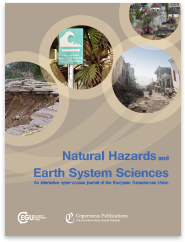 Invited perspectives: Landslide populations – can they be predicted? – 1 July 2021
Invited perspectives: Landslide populations – can they be predicted? – 1 July 2021
This is a perspective based on personal experience on whether a large number of landslides caused by a single trigger (e.g. an earthquake, an intense rainfall, a rapid snowmelt event) or by multiple triggers in a period can be predicted, in space and time, considering the consequences of slope failures.
Other highlights
Atmospheric Measurement Techniques:
VAHCOLI, a new concept for lidars: technical setup, science applications, and first measurements – 7 July 2021
Microbial and geo-archaeological records reveal the growth rate, origin and composition of desert rock surface communities – 19 July 2021
Deoxygenation dynamics on the western Nile deep-sea fan during sapropel S1 from seasonal to millennial timescales – 2 July 2021
Fracking bad language – hydraulic fracturing and earthquake risks – 21 July 2021
SOIL:
SoilGrids 2.0: producing soil information for the globe with quantified spatial uncertainty – 28 July 2021
Comment on “Exceptionally high heat flux needed to sustain the Northeast Greenland Ice Stream” by Smith-Johnsen et al. (2020) – 5 July 2021
Faster decline and higher variability in the sea ice thickness of the marginal Arctic seas when accounting for dynamic snow cover – 16 July 2021
Mapping the aerodynamic roughness of the Greenland Ice Sheet surface using ICESat-2: evaluation over the K-transect – 26 July 2021

